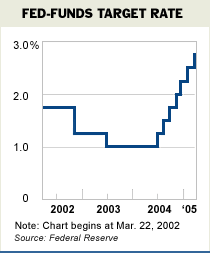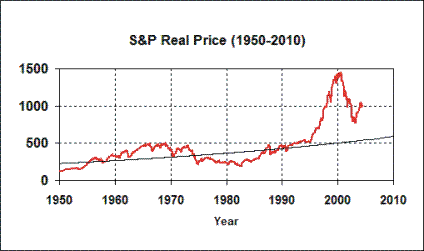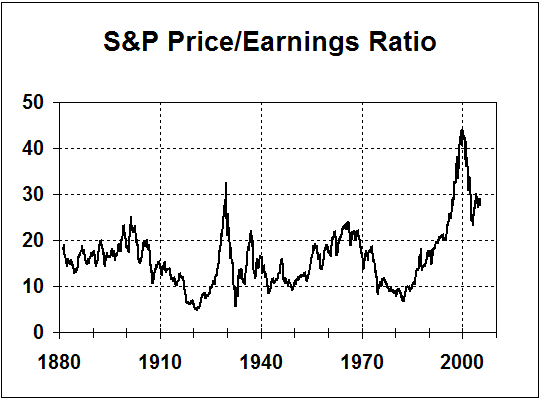
Dynamics

|
Generational Dynamics |
| Forecasting America's Destiny ... and the World's | |
| HOME WEB LOG COUNTRY WIKI COMMENT FORUM DOWNLOADS ABOUT | |
|
On Tuesday, the Federal Open Market Committee raised short-term interest rates 1/4% to 2.75%.
 |
There have been seven 1/4% increases in rapid succession, and according to the statement issued yesterday by the Fed, "the Committee believes that policy accommodation can be removed at a pace that is likely to be measured."
To Fed watchers, this means that the Fed is going to accelerate the the interest rate increases to 1/2% increments rather than 1/4% increments, in order to head off inflation. We'll have more to say about inflation below.
This aggressive strategy is expected to have several effects:
 |
First, credit card rates are going to increase. If you have credit card debt, you can expect to be charged higher interest rates, and you may find it harder to obtain additional credit. If you have an "adjustable rate mortgage," your mortgage payment will increase substantially next year. Expect to see an increase in bankruptcies.
Second, since stocks are overpriced by about 100%, based on standard price/earnings ratios (see "Price / Earnings ratios" below), stock prices will suffer. The current stock market bubble, illustrated in the adjoining graphic, began in 1995, and has been sustained by the Fed's near-zero interest rate policy.
Now that the Fed is reversing that policy, stocks are going to be far less attractive, and can be expected to fall. Generational Dynamics predicts that we're entering a new 1930s style Great Depression, and stocks are expected to fall by 50-75%, whenever the appropriate trigger occurs. This might happen next week, next month, next year, or later.
 |
The main reason that it can't be avoided is that, as the adjoining graph shows,
American public debt has been growing exponentially since 1950, and can no longer be stopped. It's like a ball rolling downhill. At first it rolls slowly, and someone could easily stop it and even push it back up the hill. But after a while the ball gains so much energy, speed and momentum that it can no longer be stopped, and we've reached that point.
Generational Dynamics forecasting tells you what your final destination is, but doesn't always tell you how you'll get there. In 2002, we predicted that the stock market would fall to the Dow 3000 range, which is what the analysis indicates. At that time, I expected that the stock market would keep falling, as it had in the 1930s, reaching Dow 3000 in the 2006 to 2007 time frame.
I wish it had happened that way. Instead, the stocks have gotten more and more expensive, indicating that the late 90s asset bubble has morphed into a new credit bubble. The final destination is the same, but the path will be far more painful. We now expect a financial "tsunami" that will cause a very rapid fall in stock prices, down to the Dow 3000 range, occurring so quickly that most investors will be unable to react quickly enough to save themselves.
It's worth noting that Alan Greenspan himself has been making statements that are increasingly alarming, a marked change from his statements of confidence a year ago.
I don't give investment advice, except informally, but I'm asked this question so frequently that it's worth addressing.
It's widely believed that in case of financial crisis the dollar will become so weak as to become virtually worthless. This view is based partially on the fact that the dollar has lost some 30% of its value in the last year compared to the euro and the yen.
However, there are powerful reasons to believe that the dollar will remain strong through a severe financial crisis, including a stock market crash:
All this indicates that it's probably safe to leave your savings in cash or gold.
|
I can't tell you which path is best, because there are too many variables. It's possible that the dollar will remain so strong that the price of gold will fall, or it's possible that the price of gold will spike for a while. However, either cash or gold is much safer today than the stock market.
We now turn to another investment choice, government bonds, such as 10-year Treasury notes.
The interest rate controlled by the Fed is the "overnight funds rate," which represent the interest rate that banks pay one another for overnight loans. For ordinary investors, the bond rate most directly affected is the 3-month treasury bill. These short-term rates have been increasing steadily as the Fed has raised overnight rates.
But 10-year Treasury bills are a different story. Normally, the 10-year bond annual interest rate would go up along with the 3-month bond annual interest rate, but 10-year rates have been coming down for several months, something that Alan Greenspan called a "conundrum" last month.
However, yesterday's strong, aggressive statement has caused a sudden and massive change in direction.
Since fixed-rate home mortgage rates are tied to the 10-year treasury rates, this means that home mortgage rates will be rising.
The following table shows the 3-month and 10-year bond rates for various dates in the last year:
| Treasury Bond Yields | |||
|---|---|---|---|
| Date | 3-month maturity | 10-year maturity | Difference |
| May 11 '04 | 0.94% | 4.74% | 3.80% |
| June 11 '04 | 1.17% | 4.79% | 3.62% |
| Aug 21 '04 | 1.38% | 4.23% | 2.85% |
| Sept 21 '04 | 1.60% | 4.03% | 2.43% |
| Feb 17 '05 | 2.44% | 4.17% | 1.17% |
| Mar 23 '05 | 2.67% | 4.58% | 1.91% |
Notice that the 10-year bond rate has been falling steadily until today, when it's sharply up. This is a reaction to the Fed announcement.
What does this mean for investments in Treasury bonds?
These figures appear to indicate that investing in 10-year treasury bonds would be a good investment, and they may well be. You can invest in these bonds today, and in ten years you'll be able to redeem them with an increase in value of 4.58% annual interest.
However, there may be a big problem for many investors: These bonds may lose their liquidity; that is, if you need cash in less than ten years, then you may have to take a big loss if you try to sell them.
The reason is that many foreign countries, especially Japan and China, have been buying treasury bonds in order to support America's massive public debt.
In case of financial crisis, these countries will dump these bonds on the market. This will increase the supply of these bonds, forcing their prices down, so that your bonds will be less valuable. This means that you won't be able to sell your bonds without taking a loss. To get full value, you'll have to hold them for the full ten years.
As we said earlier, the prices of stocks have spiked way above the real values of their underlying companies the stocks represent. We estimate that the value of an S&P 500 company grows by an average of 1.34% per year, and in ordinary times, the S&P 500 stock index grows by approximately the same annual rate. But because of the bubble, since 1990, the S&P 500 stock index has grown at 6.10% per year. This has created an imbalance, where stocks are overpriced by at least a factor of two.
One way of measuring this is by comparing the price of a stock with the earnings of the company. The amount of money that a company earns is a good proxy for the real value of the company.
When the price/earnings ratio is 25, it roughly means that a company is earning $1.00 per year for each $25.00 in the price of its stock. This roughly means that an investor buying that stock can hope to earn only $1.00/$25.00 or 4% per year. At a P/E ratio of 20, the rate is $1.00/$20.00, or 5% per year.
Historically, the S&P 500 P/E ratio has averaged around 14. This corresponds to an interest rate of roughly 7%. Thus, depending on the era, you could theoretically earn 7% interest by investing in the stock market, or you could earn around 5% interest in a bank, or 4% or so by investing in Treasury bonds. The differences in interest rates have to do with risk. You earn more in stocks because there's a risk of losing everything, while you earn less in government bonds because they're backed up by the national treasury, and there's little risk.
A P/E ratio can be computed for an individual stock or for an entire group of stocks. An indvidual stock with a P/E ratio above 17 is considered overpriced, while a stock with a P/E ratio below 10 is considered underpriced. If the S&P 500 P/E index is above 17, then the entire stock market is considered overpriced.
 |
The adjacent graph shows the S&P 500 P/E ratio index since 1881. As you can see, every time in the last century it exceeded 20, it fell below 10 with 5-15 years. It went above 20 in 1995, so as of this writing, in early 2005, it's been above 20 for ten years, so a substantial collapse is just about due.
Because of the Fed's aggressive new rate increase stance, more and more investors will move their investments to the safety of higher-yielding bonds, rather than risk the stock market. This will put downward pressure on stocks.
 |
Related to the fact that the dollar is expected to stay strong is that we're in a long-term deflationary period, as shown by the adjoining graph.
Prices are expected to fall by about 30% by 2010.
Inflation rates have been growing slowly in the last year, despite the near-zero interest rates, and the skyrocketing price of oil, as the following table shows for the wholesale rates (the Producer Price Index or PPI) and retail rates (the Consumer Price Index or CPI), as shown by the following table:
Changes from preceding month
2004-2005
Mar. Apr. May June July Aug Sept Oct Nov Dec Jan. Feb
---------------- ---- ---- --- ---- ---- --- ---- ---- --- ---- ---- ---
PPI .5 .7 .6 -.1 .1 .1 .3 1.5 .6 -.3 .3 .4
---------------- ---- ---- --- ---- ---- --- ---- ---- --- ---- ---- ---
PPI "Core index" .3 .3 .1 .3 -.1 .3 .3 .3 .2 .2 .8 .1
---------------- ---- ---- --- ---- ---- --- ---- ---- --- ---- ---- ---
---------------- ---- ---- --- ---- ---- --- ---- ---- --- ---- ---- ---
CPI .5 .2 .6 .3 -.1 .1 .2 .6 .3 0 .1 n/a
---------------- ---- ---- --- ---- ---- --- ---- ---- --- ---- ---- ---
CPI "Core index" .4 .3 .2 .1 .1 .1 .3 .2 .2 .2 .2 n/a
---------------- ---- ---- --- ---- ---- --- ---- ---- --- ---- ---- ---
According to traditional economic analysis, inflation whould have skyrocketed to 10-20% in the last year, because of oil prices and Fed policy. The reason that the economy has been so resistant to inflation is because we're in a long-term deflationary period, for the reasons we've given.
How is it possible for prices to fall, even during a financial crisis?
The explanation is what I call the "crusty old bureaucracy" theory.
There is a long-term generational cycle in business, where there is a "great depression" every 70-80 years or so. In American history, a British banking failure in 1772 sent most New England businesses into bankruptcy, providing a monetary motivation for the Revolutionary War. The Panic of 1857 bankrupted many American and European businesses, leading to the Civil War. And of course the Great Depression of the 1930s was one of the causes that led to World War II.
|
From the point of view of Generational Dynamics, here's what's going on: During the 1930s Great Depression, most old businesses went bankrupt, and every new business was "lean and mean," with every employee required to pull his full weight.
In the intervening 70 years, these businesses have all been getting calcified with bureaucracies, older employees who are waiting around for retirement, middle aged employees whose job skills are obsolete, or whole departments or divisions producing products and services that people no longer want. Therefore, the average American business today is producing too many overpriced products that nobody really wants. The same calcification process has also happened with government agencies, universities, and all other organizations. This is what I call the "crusty old bureaucracy" problem.
So the economy will "correct itself," but will do so by a major adjustment like the crash of 1929. This will force all the existing businesses into bankruptcy, and the cycle will repeat with the creation of new "lean and mean" businesses. Unfortunately, the side effects of massive homelessness and even starvation will also occur.
Another side effect is that products have been getting gradually obsolete, and this has been happening on a national basis. In the extreme, once enough businesses are producing obsolete products, inflation can't increase because no one will want the products at any price. The only way to fix the problem is through massive business bankruptcies and a new set of businesses.
In the current economy, one of the most visible examples is music CDs (compact disks). There's a huge chunk of business associated with manufacturing, distributing and selling CDs. However, CDs are becoming increasingly obsolete, because people want their music on their computer, and don't want CDs around cluttering up their homes. In other words, people don't want CDs at any price. CDs is one example, but you can easily think of many more examples in other domains where computerization are making products obsolete, or at least way overpriced. After the financial crisis, it will turn out that there are many products like that, and so prices will remain low and inflation will remain low.
We're at a unique time in history, about 60 years after the end of World War II, when every country is experiencing the same generational change at the same time: The people in the generation that fought in WW II are all disappearing (retiring or dying) all at once, and are being replaced by the people in the generation born after WW II. This new generation has no personal knowledge of the horrors of World War II, and will lead the world into a new world war. As I've described in the discussion of the six most dangerous regions of the world, the time is not too far off when a regional war in one of these regions will trigger a much wider war that will engulf America and the world.
You can see this happening today especially in the Northern Pacific, where the level of conflict is increasing on an almost daily basis, and both China and North Korea are evidently planning preemptive wars of reunification (with Taiwan and South Korea, respectively). These wars might begin next week, next month, next year, or thereafter.
|
What will life be like for the next few years? It turns out that we have a pretty good idea. Historians William Strauss and Neil Howe have studied what's happened in previous American crisis periods, and have published their findings in two books, Generations and The Fourth Turning. In fact, their generational theory forms the basis of Generational Dynamics.
Based on what happened during the previous crisis periods -- World War II, the Civil War, and the Revolutionary War, they tell us (in The Fourth Turning, p. 258) what's going to happen:
When society approaches the climax of a crisis, it reaches a point of maximum civic power. Where the new values regime had once justified individual fury, it now justifies public fury. Wars become more likely and are fought with efficacy and finality. The risk of revolution is high -- as is the risk of civil war, since the community that commands the greatest loyalty does not necessarily coincide with political (or geographic) boundaries. Leaders become more inclined to define enemies in moral terms, to enforce virtue militarly, to refuse all compromise, to commit large forces in that effort, to impose heavy sacrifices on the battlefield and home front, to build the most destructive weapons contemporary minds can imagine, and to deploy those weapons if needed to obtain an enduring victory.
One of the political consequences is that programs like Social Security, Medicare and Medicaid will be discontinued or substantially cut back. In a time when the survival of the nation is at stake, the needs of the elderly will have to give way to the needs of the young. By 2010, it will be very difficult for a non-wealthy older person to survive comfortably.
This is the kind of world we're headed for. It won't be the end of the world, but it will be worse than the horrors of the Great Depression and World War II. America has gone through this kind of thing three times before, and will do so again.
As I've done before, I'm cautioning all my readers to be taking steps to protect yourself, your family and your nation. The world today is much worse than it was a year ago, and things are getting worse every day. The public debt situation and the level of world conflict grow, and more and more commentators are noticing it. We must come together as a nation to protect one another, because we are going to have no choice.